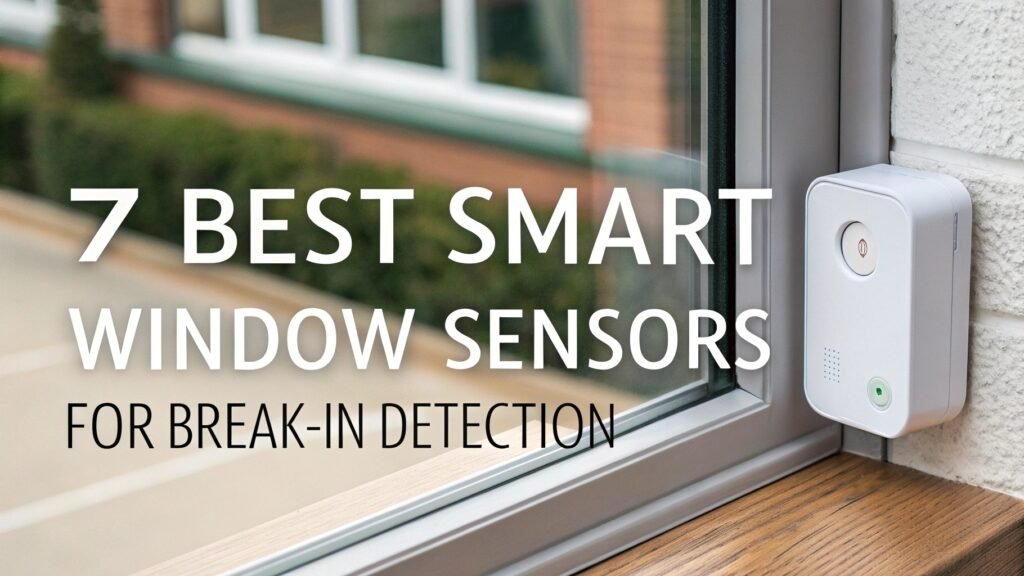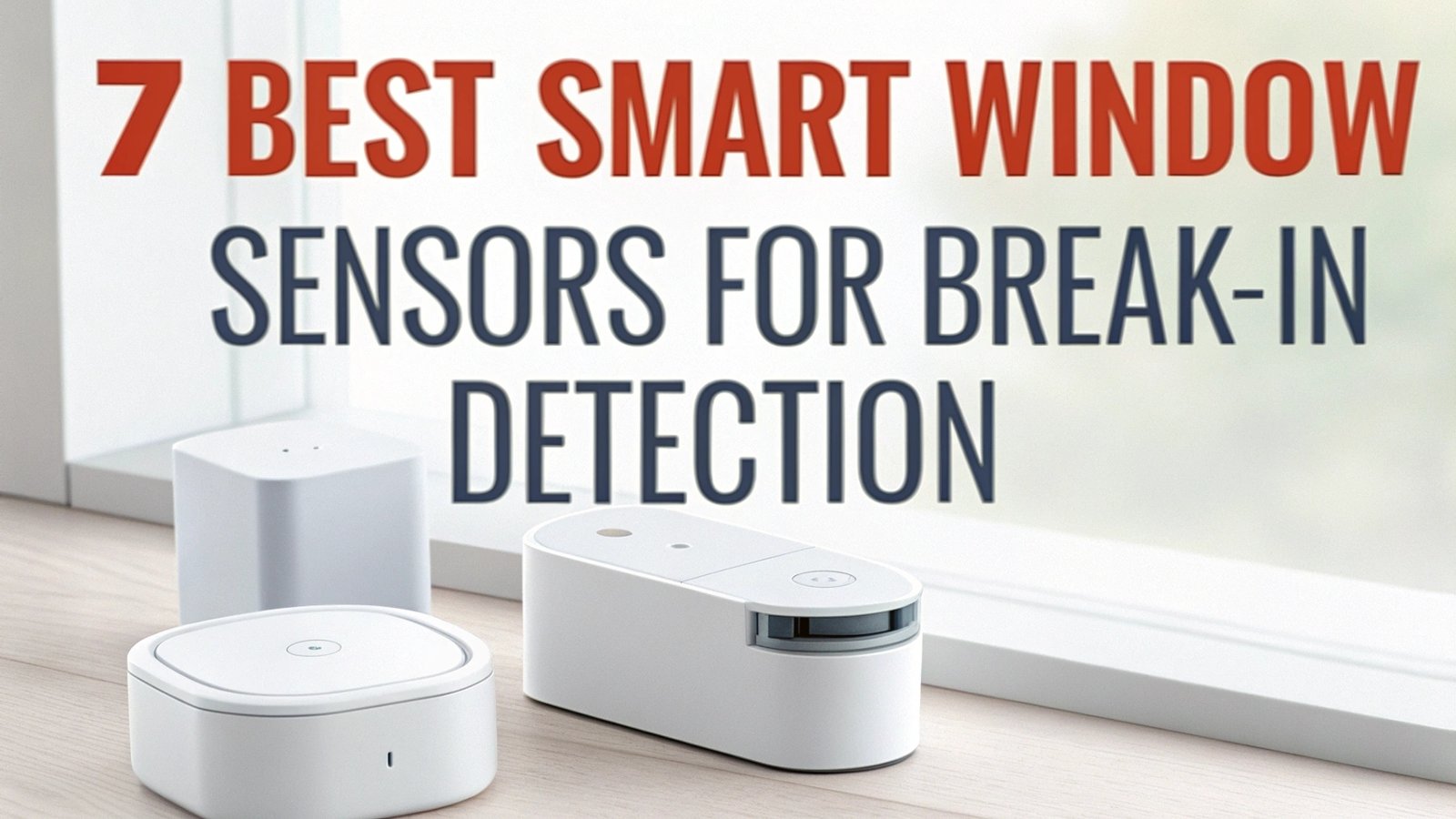7 Best Smart Window Sensors for Break-in Detection
Smart window sensors have become essential components of modern home security systems. These compact devices detect unauthorized entry attempts through windows and doors, sending immediate notifications to your smartphone.
Unlike traditional security systems that require professional installation and monthly monitoring fees, today’s smart sensors offer DIY installation and direct smartphone connectivity.
They integrate seamlessly with popular smart home platforms like Alexa, Google Assistant, and Apple HomeKit.

Key Takeaways
- Multiple Detection Types: The best window sensors combine contact detection for opening windows with vibration sensors for glass break detection, providing comprehensive protection against different entry methods.
- Long Battery Life: Premium sensors offer 3-5 year battery life, reducing maintenance needs and ensuring consistent protection without frequent battery replacements.
- Smart Home Integration: Top sensors work with Alexa, Google Assistant, and Apple HomeKit, allowing voice control and integration with existing smart home routines and automation.
- Extended Range Options: Advanced sensors like YoLink offer up to 1/4 mile range using LoRa technology, perfect for large properties or detached buildings like garages and sheds.
- Installation Flexibility: Modern sensors feature ultra-thin designs and multiple mounting options including adhesive tape and magnetic mounts, fitting virtually any window frame without drilling.
Ring Alarm Contact Sensor – Professional Grade Protection
The Ring Alarm Contact Sensor represents the gold standard for window and door protection. This second-generation sensor combines sleek design with professional-grade security features. The device measures just 3.2 inches long and fits discretely on any window frame.
Installation takes minutes using the included adhesive strips. The sensor consists of two parts – the main sensor and a small magnet. When the window opens, the magnetic connection breaks and triggers an instant alert to your phone through the Ring app. The device connects to your Ring Alarm Base Station and integrates seamlessly with other Ring security products.
Battery life extends approximately three years using the included lithium battery. The sensor reports battery status through the Ring app, providing advance warning when replacement becomes necessary. Temperature monitoring ensures reliable operation in extreme weather conditions from -20°F to 120°F.
Pros:
- Professional grade reliability with proven track record
- Ultra-slim design fits any window frame
- Excellent app integration with detailed notifications
- Works with Ring Alarm ecosystem and Alexa
- Three-year battery life reduces maintenance
Cons:
- Requires Ring Alarm Base Station (sold separately)
- Premium pricing compared to standalone options
- Limited to Ring ecosystem
YoLink LoRa Smart Door Window Sensor – Extended Range Champion
YoLink revolutionizes window sensor technology with LoRa (Long Range) connectivity that reaches up to 1/4 mile in open areas. This impressive range makes it perfect for large properties, detached garages, sheds, or any remote building that needs monitoring.
The sensor uses innovative LoRa technology instead of traditional WiFi or Zigbee. This approach delivers several advantages including longer range, better wall penetration, and exceptional battery efficiency. Battery life extends up to five years using two AAA batteries, among the longest in the industry.
Smart automation features include door left-open reminders that alert you if windows or doors remain open longer than your specified time limit. The YoLink app provides detailed history logs showing exactly when each sensor was triggered. Integration works with Alexa, IFTTT, and Home Assistant for advanced automation possibilities.
Professional monitoring capabilities allow multiple users to receive alerts simultaneously. The system supports unlimited sensors, making it scalable for any property size from apartments to large estates.
Pros:
- Exceptional 1/4 mile range using LoRa technology
- Outstanding five-year battery life
- Door left-open reminder automation
- Works with multiple smart home platforms
- Affordable pricing with premium features
Cons:
- Requires YoLink Hub (included in starter kits)
- LoRa technology less common than WiFi/Zigbee
- Limited third-party integrations compared to major brands
Aqara Zigbee Door Window Sensor – Compact Smart Home Integration
Aqara sensors excel in ultra-compact design and seamless smart home integration. These tiny sensors measure just 1.5 inches tall, making them virtually invisible when installed. Despite their small size, they pack advanced features typically found in larger sensors.
The Zigbee 3.0 protocol ensures reliable connectivity with excellent battery efficiency. Three sensors are included in this package, providing comprehensive coverage for multiple windows at an excellent value. Each sensor reports opening/closing status instantly with sub-second response times.
Smart home integration stands out as a key strength. The sensors work natively with Apple HomeKit, Alexa, and Google Assistant without requiring additional configuration. Advanced users can create complex automations using platforms like Home Assistant and IFTTT.
Installation flexibility accommodates various window types. The sensors work on wooden, metal, and vinyl frames using either adhesive mounting or the included screws. The two-piece design consists of the main sensor and a separate magnet piece.
Pros:
- Ultra-compact design – smallest sensors available
- Excellent smart home platform compatibility
- Three sensors included for great value
- Fast response times under one second
- Works with Apple HomeKit natively
Cons:
- Requires Aqara Hub for full functionality
- Small battery (CR2032) may need more frequent replacement
- Limited range compared to WiFi options
Ring Alarm Glass Break Sensor – Acoustic Detection Technology
Glass break sensors provide a different type of protection compared to contact sensors. Instead of detecting window opening, they listen for the specific acoustic signature of breaking glass. The Ring Glass Break Sensor can monitor multiple windows from a single location, making it cost-effective for rooms with several windows.
Advanced acoustic analysis differentiates between glass breaking and other sounds like dishes clattering or doors slamming. The sensor analyzes both the initial impact sound and the secondary sound of glass fragments hitting surfaces. This dual-analysis approach virtually eliminates false alarms.
Coverage area extends up to 25 feet from the sensor location, allowing one device to protect an entire room. The sensor mounts on walls or ceilings using included hardware. Professional installation recommendations suggest placing sensors within clear line-of-sight of protected windows.
Integration with the Ring ecosystem provides professional monitoring options and coordination with other Ring devices. When glass breaks, the sensor can trigger Ring cameras to start recording and Ring lights to activate, creating a comprehensive security response.
Pros:
- Protects multiple windows from single location
- Advanced acoustic analysis reduces false alarms
- 25-foot coverage radius
- Integrates with complete Ring security system
- Professional monitoring options available
Cons:
- Higher price point than contact sensors
- Requires Ring Alarm Base Station
- May not detect all types of glass breaking
- Positioning is critical for optimal performance
Aqara Vibration Sensor – Multi-Purpose Glass Break Detection
The Aqara Vibration Sensor takes a unique approach to window protection by detecting physical vibrations rather than acoustic signatures. This method proves effective for detecting both attempted break-ins and actual glass breaking. The sensor’s versatility extends beyond window protection to safes, artwork, and other valuable items.
Adjustable sensitivity settings allow customization for different protection scenarios. High sensitivity detects gentle tapping or prying attempts, while lower settings focus on stronger impacts like glass breaking. The sensor can differentiate between different types of movement including tilt, drop, and vibration.
Compact wireless design measures just 1.6 inches square, making it easy to hide on window frames or attach directly to glass. The strong adhesive mounting works on various surfaces including glass, wood, and metal. Battery life extends up to two years using the included CR2450 battery.
Smart home automation capabilities enable creative security scenarios. The sensor can trigger lights, cameras, or alarms based on detected vibrations. Integration with HomeKit allows Siri voice commands and iPhone automation shortcuts.
Pros:
- Detects vibrations before glass breaks
- Adjustable sensitivity for different scenarios
- Extremely compact and discreet design
- Works with Apple HomeKit and other platforms
- Can protect safes and valuables beyond windows
Cons:
- May be sensitive to environmental vibrations
- Requires Aqara Hub for full functionality
- Shorter battery life than contact sensors
- Learning curve for optimal sensitivity adjustment
WiFi Smart Window Vibration Sensor – Standalone Protection
This standalone WiFi sensor eliminates the need for additional hubs or base stations. Direct WiFi connectivity allows the sensor to communicate directly with your smartphone through a dedicated app. This approach simplifies installation and reduces overall system costs.
Adjustable vibration sensitivity accommodates different window types and security preferences. The sensor detects impacts, vibrations, and glass breaking attempts with customizable alert thresholds. Users can fine-tune sensitivity to minimize false alarms while maintaining security effectiveness.
130dB built-in alarm provides immediate local deterrence when triggered. The loud alarm can startle intruders and alert neighbors even if your phone is unavailable. App-based controls allow you to disable the local alarm for silent monitoring when desired.
Remote monitoring capabilities include real-time alerts with detailed timestamps and event logging. The app maintains a complete history of all sensor activations, helping identify patterns or frequent false triggers. Multiple users can receive notifications simultaneously.
Pros:
- No hub required – direct WiFi connection
- Built-in 130dB alarm for immediate deterrence
- Adjustable sensitivity settings
- Real-time smartphone alerts
- Affordable standalone solution
Cons:
- Depends on WiFi reliability
- Battery life shorter than low-power protocols
- Limited smart home platform integration
- Single sensor design limits coverage area
YoLink Vibration Sensor – Long Range Vibration Detection
YoLink extends their impressive LoRa technology to vibration detection with this specialized sensor. 1/4 mile range capability makes it ideal for protecting remote buildings, RVs, or any location where traditional WiFi sensors cannot reach reliably.
Advanced vibration algorithms distinguish between different types of movement and impacts. The sensor detects attempts to break glass, pry windows, or force entry while ignoring environmental factors like wind or passing traffic. Sensitivity adjustment helps optimize performance for specific installations.
Five-year battery life using two AAA batteries represents exceptional efficiency for a vibration sensor. This extended operation reduces maintenance requirements and ensures consistent protection over many years. Battery status monitoring through the YoLink app provides advance replacement warnings.
Integration capabilities include Alexa, IFTTT, and Home Assistant support for advanced automation scenarios. The sensor can trigger cameras, lights, alarms, or other security devices when vibrations are detected. Professional monitoring services can integrate with YoLink systems for comprehensive security coverage.
Pros:
- Exceptional 1/4 mile range using LoRa technology
- Five-year battery life – industry leading
- Advanced vibration detection algorithms
- Professional monitoring integration options
- Works in areas without WiFi coverage
Cons:
- Requires YoLink Hub (sold separately)
- Higher initial cost than basic sensors
- LoRa technology less familiar to most users
- Limited availability compared to major brands
EVA LOGIK Ultra-Thin Window Vibration Sensor – Budget Excellence
EVA LOGIK delivers impressive features at an accessible price point with their ultra-thin vibration sensor design. The 4-pack configuration provides excellent value for protecting multiple windows or giving sensors to family members for their homes.
120dB built-in alarm provides immediate local deterrence when vibrations are detected. The alarm volume is sufficient to startle intruders and alert neighbors without being excessively loud for daily living. Users can activate or deactivate the alarm function based on specific security needs.
Universal compatibility works with virtually any window type including wooden, vinyl, aluminum, and steel frames. The ultra-thin profile measures less than 1/4 inch thick, making it nearly invisible when installed. Strong adhesive mounting eliminates the need for drilling or permanent modifications.
Simple operation requires no smartphone apps or complex setup procedures. The sensors operate independently with on/off switches and sensitivity adjustment controls located directly on each unit. This simplicity appeals to users who prefer straightforward security solutions.
Pros:
- Excellent value with four sensors included
- Ultra-thin design fits any window frame
- Built-in 120dB alarm for immediate deterrence
- No apps or hubs required – completely standalone
- Simple operation with manual controls
Cons:
- No smartphone connectivity or remote monitoring
- Battery life shorter than smart alternatives
- Limited automation or integration capabilities
- Basic features compared to smart sensors
Understanding Window Sensor Technology Types
Window sensors employ different detection methods to identify security threats. Contact sensors use magnetic switches to detect when windows open. These sensors consist of two parts – a main sensor containing the electronics and a small magnet. When the window opens, the magnetic field breaks and triggers an alert.
Vibration sensors detect physical impacts on windows or frames. These devices use accelerometers to measure movement and vibration patterns. Advanced models can distinguish between different types of impacts, ignoring minor vibrations from wind while detecting forceful attempts to break glass.
Glass break sensors listen for the acoustic signature of breaking glass. These sensors analyze sound frequencies to identify the specific pattern of glass shattering. Modern acoustic sensors use dual-stage detection that listens for both the initial impact and subsequent sound of glass fragments falling.
Combination sensors merge multiple detection methods into single devices. These advanced sensors provide comprehensive protection by monitoring for window opening, glass breaking, and forced entry attempts simultaneously.
Installation Best Practices for Maximum Protection
Proper installation significantly impacts sensor performance and reliability. Contact sensors work best when the magnet aligns precisely with the sensor’s magnetic detection area. Most sensors include alignment guides or marks to ensure optimal positioning.
Surface preparation improves adhesive mounting reliability. Clean window frames with alcohol or degreasing agents before applying sensors. Ensure surfaces are completely dry and free from dust, paint chips, or other debris that might prevent proper adhesion.
Temperature considerations affect both installation and long-term performance. Install sensors during moderate temperature conditions when possible. Extreme heat or cold during installation can impact adhesive bonding strength.
Testing procedures should verify proper operation before relying on sensors for security. Most smart sensors include test modes that confirm connectivity and alert functionality. Perform physical tests by opening windows or creating controlled vibrations to verify sensor response.
Smart Home Integration and Automation Ideas
Modern window sensors excel at smart home integration beyond basic security alerts. Lighting automation can automatically turn on lights when windows open after dark. This feature provides convenience while potentially deterring intruders who prefer darkness.
Climate control integration helps maintain energy efficiency by detecting open windows. Smart thermostats can pause heating or cooling when windows open, preventing energy waste. Some systems can automatically adjust temperature settings based on window status.
Security system coordination allows window sensors to trigger cameras, alarms, or other security devices. When sensors detect unauthorized entry, they can activate recording, sound alarms, and alert multiple family members simultaneously.
Voice control integration with Alexa, Google Assistant, or Siri enables hands-free monitoring. Users can ask voice assistants about window status or receive verbal confirmations about sensor conditions.
Battery Life and Maintenance Considerations
Battery technology significantly impacts sensor reliability and maintenance requirements. Lithium batteries typically provide longer life than alkaline alternatives while maintaining consistent voltage output. Most premium sensors use lithium cells exclusively.
Low-power protocols like Zigbee and LoRa extend battery life compared to WiFi sensors. These technologies use less power for communication, allowing batteries to last 3-5 years in typical use. WiFi sensors may require annual battery replacement.
Battery monitoring through smartphone apps provides advance warning when replacement becomes necessary. Smart sensors typically alert users when battery levels drop below 20%, providing several weeks of continued operation.
Seasonal maintenance helps ensure optimal performance. Check sensor alignment, clean mounting surfaces, and verify proper operation at least twice yearly. Temperature extremes can affect adhesive mounting and battery performance.
Security System Integration Options
Professional monitoring services can integrate with many smart window sensors for comprehensive security coverage. These services provide 24/7 monitoring and emergency response coordination when sensors trigger alerts.
DIY monitoring using smartphone apps allows users to maintain complete control over their security systems. Most sensors provide detailed activity logs and customizable alert settings without monthly monitoring fees.
Hybrid approaches combine DIY monitoring with professional backup services. Users can monitor their systems directly while having professional services available for extended absences or emergency situations.
Emergency response integration can automatically contact authorities when sensors detect break-in attempts. Advanced systems coordinate with local police and fire departments for rapid emergency response.
Cost Analysis and Value Comparison
Initial investment varies significantly between basic and smart sensor options. Simple vibration sensors cost $10-20 each, while comprehensive smart sensors range from $20-50 per unit. Professional-grade sensors with advanced features may cost $50-100 each.
Long-term costs include battery replacement, potential monitoring fees, and system upgrades. Factor these ongoing expenses when comparing different sensor options. Sensors with longer battery life provide better long-term value despite higher initial costs.
Value proposition extends beyond simple cost comparison. Smart sensors provide convenience, automation capabilities, and integration options that justify premium pricing for many users. Consider total ownership costs over 5-10 years when making decisions.
Scalability considerations affect cost-effectiveness for larger properties. Systems that support unlimited sensors without additional fees provide better value for comprehensive coverage.
Frequently Asked Questions
How do smart window sensors differ from traditional alarm systems?
Smart window sensors connect directly to your smartphone through WiFi or dedicated hubs, eliminating the need for professional monitoring services. Traditional alarm systems typically require monthly monitoring fees and professional installation. Smart sensors offer DIY installation, direct smartphone alerts, and integration with existing smart home devices.
Can window sensors work without internet connectivity?
Some sensors function independently of internet connectivity. Basic vibration sensors with built-in alarms operate completely offline, providing local deterrence even during internet outages. However, smartphone alerts and remote monitoring require active internet connections through WiFi, cellular, or LoRa networks.
What is the difference between contact sensors and glass break sensors?
Contact sensors detect when windows or doors open by monitoring magnetic field changes. Glass break sensors listen for the acoustic signature of breaking glass. Contact sensors only trigger when openings occur, while glass break sensors detect forced entry through breaking glass without opening windows.
How long do smart window sensor batteries typically last?
Battery life varies significantly by sensor type and technology. Premium sensors using Zigbee or LoRa protocols typically last 3-5 years on single battery sets. WiFi sensors may require annual battery replacement due to higher power consumption. Vibration sensors generally have shorter battery life due to continuous monitoring requirements.
Are smart window sensors compatible with existing home security systems?
Compatibility depends on the specific sensor and security system combination. Many smart sensors integrate with popular platforms like Ring, SimpliSafe, and ADT through direct compatibility or hub connections. Check manufacturer specifications for confirmed compatibility with your existing security system.
Can multiple family members receive alerts from the same sensors?
Most smart sensor systems support multiple user notifications. Smartphone apps typically allow unlimited user accounts with customizable alert preferences. Family members can receive simultaneous notifications with different alert types based on individual preferences and security roles.
Do window sensors work on all types of windows?
Modern sensors accommodate virtually all window types including wooden, vinyl, aluminum, and steel frames. Ultra-thin designs fit narrow frames, while adjustable mounting options work with various window configurations. Some sensors include multiple mounting accessories for different installation scenarios.
How can I reduce false alarms from window sensors?
Adjust sensitivity settings to match your specific environment and security needs. Install sensors away from high-vibration areas like air conditioning units or busy streets. Ensure proper alignment of magnetic components in contact sensors. Regular maintenance and testing help identify and resolve false alarm sources.

I’m Liza, the founder and author of Liza AI Blog, where I share my passion for artificial intelligence through insightful guides and updates. I’m dedicated to making AI accessible to everyone, and I strive to create a community that’s both informed and engaged. Through my blog, I aim to promote a deeper understanding and appreciation of AI and its potential to shape our future. You can reach me at lizaaiblog@gmail.com or follow me on social media to stay updated on the latest AI news and trends.







